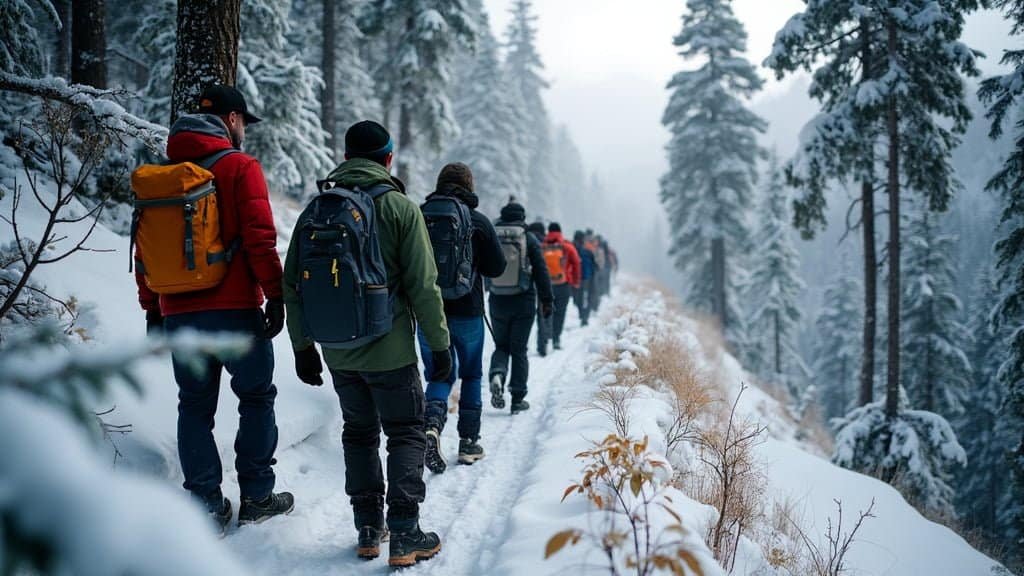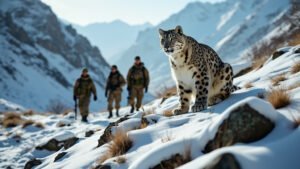Introduction
Community-based conservation has emerged as a vital approach to protecting snow leopards, a species that faces numerous threats in its mountainous habitats. By involving local communities directly in conservation efforts, these initiatives not only help safeguard snow leopards but also provide tangible benefits to the people who share their environment
From reducing poaching and human-wildlife conflict to promoting eco-tourism and education, community-based conservation empowers locals to become active stewards of their natural resources
This article explores how these grassroots efforts are making a significant difference in the fight to protect snow leopards, examining key strategies such as reducing poaching, promoting eco-tourism, and implementing livestock protection programs
Understanding Community-Based Conservation
Community-based conservation is a strategy that involves local populations in the stewardship and management of natural resources and wildlife. This approach recognizes that the people who live closest to wildlife habitats are best positioned to protect them, provided they have the necessary support and incentives
In the context of snow leopard conservation, community-based initiatives have proven instrumental in fostering coexistence between humans and these elusive big cats
Definition and Key Principles
At its core, community-based conservation (CBC) is founded on the principle of participatory management, where local communities are not just beneficiaries but active participants in conservation efforts
The key principles of CBC include:
Local Empowerment: Empowering local communities to make decisions regarding the management of their natural resources
Benefit Sharing: Ensuring that the communities derive tangible benefits from conservation activities, which may include financial incentives, improved livelihoods, and enhanced ecosystem services
Cultural Sensitivity: Recognizing and integrating traditional knowledge and cultural practices into conservation strategies
Sustainability: Focusing on long-term conservation goals that balance ecological integrity with community well-being
By adhering to these principles, CBC aims to create a sense of ownership and responsibility among local populations, thereby enhancing the effectiveness and sustainability of conservation efforts
Benefits for Snow Leopards and Local Communities
Implementing community-based conservation programs yields numerous benefits for both snow leopards and the human populations that share their habitats
For Snow Leopards
Reduced Poaching: When communities are involved in conservation, there is a significant decrease in poaching activities. Locals become the eyes and ears on the ground, monitoring and reporting illegal activities
Habitat Preservation: Engaged communities are more likely to participate in habitat restoration and protection, ensuring that snow leopards have the necessary space and resources to thrive
Conflict Mitigation: Through education and the implementation of conflict mitigation strategies, such as predator-proof livestock enclosures, the instances of retaliatory killings decrease
For Local Communities
Economic Opportunities: Conservation programs often introduce alternative livelihood options, such as eco-tourism or handicraft production, providing additional income sources
Capacity Building: Communities gain access to training and resources that enhance their skills in wildlife monitoring, sustainable agriculture, and other areas
Enhanced Ecosystem Services: Healthy ecosystems provide services such as clean water, fertile soil, and climate regulation, all of which benefit local populations
By aligning the interests of snow leopard conservation with community development goals, CBC creates a synergistic relationship that promotes the well-being of both
Importance of Local Involvement
The involvement of local communities is crucial for several reasons:
Intimate Knowledge of the Land: Locals possess a deep understanding of the terrain, wildlife behaviors, and ecological dynamics, making them invaluable partners in monitoring and conservation efforts
Sustainable Resource Use: When communities are involved in decision-making, they are more likely to adopt sustainable practices that balance their needs with environmental conservation
Conflict Resolution: Engaging locals in conservation fosters dialogue and collaboration, which are essential for resolving human-wildlife conflicts effectively
Cultural Preservation: Incorporating traditional knowledge and cultural values into conservation strategies ensures that these efforts are respectful and relevant to the communities involved
In the context of snow leopard conservation, the participation of local communities has led to innovative solutions that address both conservation and community needs
For example, in parts of Nepal and Mongolia, community-managed grazing areas and rotational grazing practices have been implemented to reduce habitat degradation, benefiting both livestock and snow leopards
Reducing Poaching Through Local Engagement
One of the most significant challenges in snow leopard conservation is poaching, driven by the demand for pelts, bones, and other body parts
Community-based conservation offers a powerful approach to reducing poaching by actively involving local populations in protection efforts. Through education, economic incentives, and the integration of traditional knowledge, these initiatives help transform communities from passive bystanders into proactive guardians of snow leopards
Empowering Locals as Conservation Stewards
Central to the success of community-based conservation is the empowerment of local communities as stewards of their environment. By giving them a stake in the conservation process, locals become motivated to protect snow leopards and other wildlife from poaching
Training and Capacity Building: Many community-based programs provide training to locals in wildlife monitoring, anti-poaching patrols, and data collection. For instance, community rangers are often trained to identify signs of poaching, such as snares and traps, and to report these to authorities
This grassroots involvement is crucial in regions where governmental conservation resources are limited, and local knowledge can significantly enhance surveillance efforts
Establishing Community Conservation Areas: In some regions, communities have been given the authority to manage their own conservation areasThese areas are often designated as no-hunting zones, where poaching is strictly prohibited, and are managed by community members who enforce the rules and monitor wildlife populations
The success of these conservation areas is evident in regions like the Annapurna Conservation Area in Nepal, where community management has led to an increase in snow leopard sightings and a reduction in poaching
Incentivizing Poaching Alternatives
To reduce the financial incentives for poaching, community-based conservation programs often introduce alternative sources of income that are sustainable and conservation-friendly
These alternatives help shift the economic reliance away from illegal activities:
Eco-Friendly Livelihoods: Programs like the Snow Leopard Enterprises initiative encourage locals to produce and sell handicrafts, such as woolen products, in exchange for a commitment to protect snow leopards
These handicrafts are then sold on the international market, providing a steady source of income for participating families. By linking economic benefits directly to the preservation of snow leopards, these programs create a powerful incentive for locals to protect, rather than poach, these animals
Wildlife Tourism: Eco-tourism has proven to be a highly effective tool in snow leopard conservation. By developing tourism activities that focus on snow leopard tracking, wildlife photography, and cultural experiences, communities can generate significant revenue
This not only provides jobs and economic benefits but also raises awareness about the importance of conserving snow leopards. Regions like Ladakh in India have seen a rise in eco-tourism, with tourists flocking to the area for a chance to glimpse the elusive snow leopard, thereby increasing local support for conservation efforts
Role of Traditional Knowledge in Protection
Traditional knowledge and cultural practices can play a vital role in snow leopard conservation. Many indigenous communities have lived alongside snow leopards for generations and possess a deep understanding of their behavior, habitat, and ecological role:
Integrating Traditional Practices: Conservation programs that integrate traditional practices, such as community-led patrols and rotational grazing systems, often see greater success. For example, in Kyrgyzstan, the use of traditional herding practices has been revived to prevent overgrazing and reduce human-wildlife conflicts, indirectly benefiting snow leopard populations.
Cultural Respect and Conservation: Respecting and incorporating cultural beliefs into conservation strategies helps ensure local buy-in and long-term commitment. In some communities, snow leopards are revered as sacred animals
Conservation programs that acknowledge and support these beliefs can build stronger alliances with local populations. This cultural respect can translate into more effective protection efforts, as locals are more likely to engage in conservation when their traditions and values are honored
Eco-Tourism as a Tool for Conservation
Eco-tourism has emerged as one of the most effective tools in the conservation of snow leopards. By transforming the natural allure of these elusive cats into a sustainable source of income, eco-tourism incentivizes local communities to protect their environment
This approach not only raises awareness about snow leopard conservation but also provides economic benefits to those living in proximity to snow leopard habitats
Financial Incentives for Preservation
The economic potential of eco-tourism serves as a powerful motivator for conservation. Snow leopards, known for their elusive nature, are a major draw for wildlife enthusiasts, photographers, and adventure travelers
This demand creates opportunities for communities to generate income by offering guided tours, homestays, and other related services:
Creating Jobs and Income Streams: Eco-tourism creates direct and indirect employment opportunities for local residents, ranging from wildlife guides and trackers to hospitality staff and artisans
In regions like Ladakh in India and the Altai Mountains in Mongolia, eco-tourism has led to the establishment of community-run guesthouses, restaurants, and craft shops. These businesses not only provide income but also promote local culture and products, adding further value to the community
Supporting Conservation Efforts: A portion of the revenue generated from eco-tourism is often reinvested into local conservation projects. For instance, entrance fees to snow leopard tracking areas, donations from tourists, and profits from eco-friendly businesses can be used to fund anti-poaching patrols, habitat restoration, and community education programs. This reinvestment creates a sustainable cycle where the preservation of snow leopards directly benefits both the species and the local economy
Examples of Successful Eco-Tourism Projects
Several eco-tourism projects have successfully contributed to snow leopard conservation by engaging local communities and international visitors alike:
Hemis National Park, India: Hemis National Park in Ladakh is one of the most famous destinations for snow leopard spotting. Local communities have capitalized on this by developing eco-tourism initiatives that cater to wildlife enthusiasts
Homestays, guided treks, and wildlife photography tours are now common, with a significant portion of the proceeds going towards snow leopard conservation efforts. The success of these initiatives has led to increased snow leopard sightings and a growing global awareness of the importance of conserving this species
Tost Mountains, Mongolia: In the Tost Mountains of Mongolia, the Snow Leopard Trust has partnered with local communities to develop eco-tourism as a conservation strategy
Tourists are offered the chance to participate in snow leopard tracking and research activities, providing them with a unique experience while contributing financially to conservation efforts. The program has helped to reduce poaching by providing alternative livelihoods and fostering a sense of pride among locals in their role as protectors of snow leopards
Shey Phoksundo National Park, Nepal: In Nepal, eco-tourism has been integrated into conservation efforts in Shey Phoksundo National Park, home to one of the largest populations of snow leopards in the country
The park offers guided snow leopard treks, where tourists can learn about the conservation challenges faced by these big cats and the measures being taken to protect them. Revenue from these activities supports local conservation programs and community development projects, further strengthening the connection between eco-tourism and conservation
Balancing Tourism and Conservation Needs
While eco-tourism offers significant benefits for snow leopard conservation, it also presents challenges that need careful management to ensure sustainability:
Minimizing Environmental Impact: Increased human activity in snow leopard habitats can lead to habitat degradation, disturbance to wildlife, and an increased risk of human-wildlife conflict. To mitigate these impacts, eco-tourism initiatives must be carefully planned and managed
This includes setting limits on the number of visitors, enforcing strict guidelines for behavior in wildlife areas, and ensuring that infrastructure development is environmentally sustainable
Community Involvement in Decision-Making: For eco-tourism to be truly effective, local communities must be involved in decision-making processes. This ensures that the benefits of tourism are equitably distributed and that the needs and concerns of the community are addressed
Community-based management of eco-tourism projects allows for greater flexibility and responsiveness to changing conditions, which is essential for balancing tourism with conservation
Education and Awareness: Educating tourists about the importance of snow leopard conservation is a key component of eco-tourism
Visitors who understand the ecological and cultural significance of snow leopards are more likely to support conservation efforts financially and advocate for the protection of these animals in their own countries. Guided tours, informational displays, and interactions with local conservationists can all contribute to raising awareness among tourists
Livestock Protection and Conflict Mitigation
Human-wildlife conflict, particularly involving livestock predation by snow leopards, is a significant challenge in snow leopard conservation. These conflicts often lead to retaliatory killings, posing a major threat to the survival of snow leopards
Community-based conservation initiatives focus on livestock protection and conflict mitigation strategies to reduce these clashes and promote coexistence between humans and snow leopards
Livestock Insurance and Compensation Schemes
Livestock predation can have devastating economic consequences for herders, who often rely on their animals as their primary source of income
In response, community-based conservation programs have introduced livestock insurance and compensation schemes to alleviate the financial burden of predation and reduce the likelihood of retaliatory killings:
Livestock Insurance Programs: These programs allow herders to insure their livestock against predation by snow leopards and other predators. If an insured animal is killed, the herder receives compensation, mitigating the financial loss
This approach has been implemented successfully in regions such as Ladakh, India, where the Snow Leopard Conservancy and its partners have established insurance programs that have significantly reduced retaliatory killings
Compensation Schemes: In areas where insurance programs are not feasible, direct compensation schemes are often used. Under these schemes, herders are compensated for their losses by conservation organizations or government agencies
The compensation is usually based on the market value of the livestock, ensuring that herders do not suffer financially from predation events. By providing timely and fair compensation, these schemes help build trust between conservationists and local communities, encouraging a more positive attitude towards snow leopards
Predator-Proof Enclosures
Another effective strategy for reducing human-snow leopard conflict is the construction of predator-proof enclosures. These structures protect livestock from nocturnal attacks by snow leopards, which are most likely to occur when animals are penned at night:
Design and Implementation: Predator-proof enclosures are typically made from sturdy materials such as stone, metal, or reinforced wood, and are designed to prevent snow leopards from entering
The enclosures are built in collaboration with local communities, ensuring that they are culturally appropriate and meet the specific needs of the herders. Conservation organizations often provide technical support and materials, while the community contributes labor and local knowledge
Success Stories: The implementation of predator-proof enclosures has been successful in several regions. For example, in the Wakhan Corridor of Afghanistan, the Wildlife Conservation Society (WCS) has worked with local communities to construct predator-proof corrals
These enclosures have led to a significant reduction in livestock losses and, consequently, a decrease in retaliatory killings of snow leopards. Similar successes have been reported in the Himalayas, where the construction of secure enclosures has fostered greater tolerance for snow leopards among local herders
Success Stories and Ongoing Challenges
While livestock protection and conflict mitigation strategies have achieved notable successes, challenges remain in ensuring their widespread and sustained implementation:
Scalability and Sustainability: One of the primary challenges is scaling up successful programs to reach more communities across the snow leopard’s range
Limited funding, logistical difficulties in remote areas, and varying levels of community engagement can hinder the expansion of these initiatives. Ensuring the long-term sustainability of livestock protection programs also requires ongoing support, monitoring, and adaptation to changing conditions
Community Engagement and Ownership: For livestock protection and conflict mitigation strategies to be effective, it is essential that local communities take ownership of these initiatives
This requires building strong relationships between conservation organizations and community members, fostering trust, and ensuring that the programs are responsive to local needs and conditions. In some cases, resistance to new practices or a lack of understanding of the benefits can pose challenges to community engagement
Balancing Conservation and Livelihoods: Striking a balance between conservation goals and the livelihoods of local communities is an ongoing challenge
While predator-proof enclosures and compensation schemes help reduce conflict, they must be integrated with broader strategies that address the underlying economic and social factors contributing to human-wildlife conflict. This includes providing alternative livelihoods, improving access to markets, and enhancing the resilience of local economies
Conclusion
Community-based conservation plays a pivotal role in the protection and preservation of snow leopards, offering a sustainable and inclusive approach that directly involves local populations in safeguarding these majestic creatures
By reducing poaching through local engagement, leveraging eco-tourism as a conservation tool, and implementing effective livestock protection and conflict mitigation strategies, these initiatives address the multifaceted challenges facing snow leopard conservation
The success of community-based efforts lies in their ability to align the interests of conservation with the economic and social well-being of local communities, fostering a sense of stewardship and ownership over wildlife and natural resources
However, the continued success of these strategies depends on overcoming challenges such as scaling up programs, ensuring long-term sustainability, and maintaining strong community engagement
By addressing these challenges and building on the successes of existing programs, we can create a future where snow leopards not only survive but thrive in the wild, supported by the very communities that share their mountainous habitats











